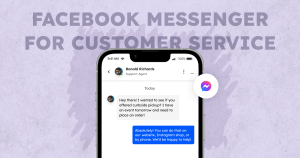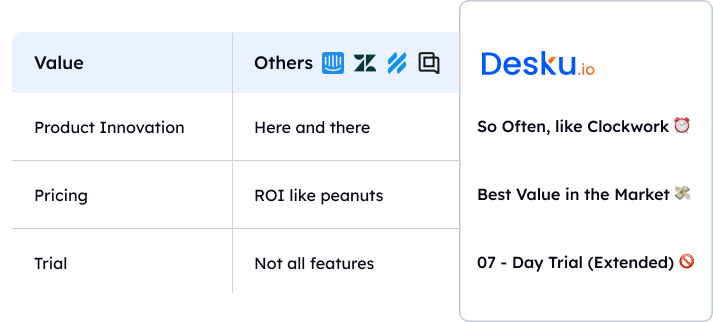Ever felt overwhelmed with the rising number of customer support tickets as your business grows? There’s a handy method to manage this situation: ticket deflection. It’s all about giving your customers the tools to sort out their issues on their own.
Not only does this cut down on your support team’s workload, it also gives your customers a sense of autonomy. Curious about how to make ticket deflection work for your business? Let’s get into it.
We’ll discuss how you can effectively apply ticket deflection strategies, ensuring your customers find quick solutions and your team can focus on more important problems. Excited? Let’s talk about turning this concept into reality for your business.
Key Takeaways
Feeling stressed with a growing number of customer support tickets as your business expands? Don’t worry, there’s a solution: ticket deflection. It’s basically about providing your customers with the resources to resolve their own issues.
This approach not only lightens the load for your support team but also empowers your customers. Wondering how to implement ticket deflection in your business? Let’s dive in.
We’ll talk about how to use ticket deflection strategies effectively, making sure your customers get fast answers and your team can concentrate on more complex issues. Ready? Let’s discuss how to turn this idea into a reality for your business.
What Is Ticket Deflection?

Have you ever heard about ticket deflection? It’s a pretty cool strategy that a lot of businesses are using nowadays to make your life as a customer a little easier. Basically, it gives you the power to solve problems on your own, without having to wait for a response from customer support. This is all made possible by things like a well-organized database of information, FAQs, and even automated chat systems.
And guess what? It’s not just helpful for you, but it also helps businesses. They can measure how well it’s working by looking at the deflection ratio. This is just fancy talk for counting how many times customers like you use self-service options versus how many times you need to open a support ticket. If the ratio is high, it means more people are finding their own solutions, which in turn means less work for the customer service team.
But here’s the best part. Ticket deflection doesn’t just make things faster, it also makes customers happier. When you’ve got the tools and resources to fix things yourself, you feel more in control. This can lead to better service, lower support costs, and more loyal customers. And let’s be clear, the goal isn’t to avoid talking to customers, but rather to give you more ways to get help quickly. Isn’t that neat?
Benefits of Ticket Deflection
Just think about it – fewer wait times, more work done, and reduced cost of support. That’s what ticket deflection brings to your business.
It’s more than just a strategy, it’s a shift that improves the experience of your customers and opens up potential for growth.
Let’s chat about how this could completely change your approach to customer support.
1. Shorter wait times
Have you ever thought about how ticket deflection strategies can benefit your business? Well, let me tell you, the perks extend beyond just cutting costs and ramping up your team’s productivity. One of the biggest wins is shorter wait times for your customers. And we all know that when customers get quick answers, they’re happier, right?
Take self-service options for example. They’re like a fast-food drive-thru for customer service. When customers have a question, they don’t have to wait in a long line for an agent to get back to them. Instead, they can look up the answer themselves in FAQs or ask a chatbot. Quick and easy!
Now, let’s think about your support team. With fewer tickets to deal with, they can focus on the trickier, more unique problems. This way, they can provide better help where it’s really needed. And the best part? With more resources freed up, they can tackle these challenging cases with greater efficiency.
2. Lower customer support costs
Imagine this: You’re trying to cut down on customer support costs. One way to do this is through something called ‘ticket deflection strategies.’ Sounds pretty cool, right? Well, they can be a real game changer. By decreasing the number of incoming tickets, your support team can be more productive.
Here’s how it works. You give customers the tools to help themselves. Think along the lines of a comprehensive, easy-to-search knowledge base ( compare top knowledge base softwares ) or a friendly AI chatbot. This way, they can quickly find the answers they need, which leaves them feeling happier overall.
And guess what? This frees up your team to take on the trickier queries, making them even more productive. So, you might want to think about ticket deflection. Not only can it save you money on support costs, but it also helps you understand your customers better. Plus, it’s a great way to keep your customers satisfied and your support system running smoothly.
3. Unlocked scalability
There’s more to ticket deflection than just cutting down on support costs; it’s also a gateway to massive growth for your business. It’s a simple, effective way to improve your customer service and learn more about your customers. With ticket deflection, you can easily expand your customer support operations.
Here’s how it works:
- Knowledge Base for Self-Service: Think of this as a library full of answers. It’s a place for customers to find their own solutions before reaching out to your team.
- Helpful Automation: Here’s where technology comes in handy. With chatbots and AI, we can handle the routine questions, leaving your team free to deal with the more challenging stuff.
- Insights from Data: Every ticket deflected is a chance to learn something new about your customers’ needs and wants.
In short, ticket deflection can transform your customer service. It’s not just about efficiency, it’s about putting the customer first. And the best part? It opens up a world of possibilities for growing your business.
4. An enhanced customer experience
Let’s talk about improving your customer service experience. Have you heard of ticket deflection? It’s a brilliant way to not only cut down on support costs but also to make your customers’ experience better.
How does it work? Well, it’s all about giving your customers the tools to solve their problems themselves, whenever they need to. This means they don’t have to wait for a response from your team, and they’ll be happier with the service they receive.
And there’s an added bonus for you too. When your customers sort out their own issues, you’ll have fewer support tickets to deal with. That means lower costs and more time to focus on other important aspects of your business. Plus, you can learn a lot about your customers by seeing which issues they can sort out themselves. This can help you improve your support strategy in the future.
5. Improves Support Team’s Productivity
Improving your support team’s productivity is a win-win situation. It not only helps your customers but also your team. Let’s chat about how ticket deflection can make this happen.
First up, we’ve this idea of ‘Supercharging Your Team’s Productivity.’ With tools like a knowledge base or chatbots, your team can streamline how they handle common issues. This means fewer tickets landing in their inbox and more time to tackle the trickier problems.
Next, let’s talk about ‘Empowering Customers with Self-Service Solutions.’ When you provide information that’s easy to find and understand, your customers can often sort things out on their own. This self-reliance not only makes your customers happier, but it also lightens the load for your team.
Finally, we come to ‘Upping the Happy Factor.’ When your team is more productive and solutions are found quicker, everyone’s satisfaction goes up. Your customers are happier because they’re getting what they need faster, and your team is happier because they’re not drowning in tickets.
6. You Learn More About Your Customers
Think about how using ticket deflection strategies can really fine-tune your support services and give you a better picture of your customers’ habits and likes. When you take a close look at how customers interact with self-service, you can start to see the kind of questions and issues that pop up for them.
All this information from deflection data is like a gold mine, giving you the ability to tweak your services to fit just right. By keeping an eye on deflection rates, you can spot the things that regularly bother your customers and get ahead of them, making their customer service experience even better.
Plus, patterns in deflection can show you what customers need, which helps you improve self-service choices and the quality of service as a whole. In the end, using ticket deflection strategies means you get to know your customers on a deeper level, making sure their support experience feels personal and satisfying.
9 Proven Ticket Deflection Strategies to Reduce Your Support Tickets

Looking to cut down on your support tickets by a significant amount?
There are tried and tested methods that can really shake things up.
You could start by building an all-encompassing database that answers common queries or even use chatbots and digital platforms to make your support process more efficient.
There’s so much you can do to make things smoother for your team.
1. Create a Knowledge Base
Building a solid, well-structured knowledge base can be a game changer in managing your support tickets. Think of it as a DIY portal where customers can seek solutions to their issues without needing to raise a support ticket.
To pull this off effectively, here are a few pointers:
- Make sure your customers can find and navigate through your knowledge base with ease.
- Keep your knowledge base fresh with up-to-date information and answers to common issues.
- Use data analysis to zero in on frequent queries and ensure they’re addressed in your knowledge base.
2. Invest in Chatbots
Think about this. You’ve got a solid knowledge base, which is great for cutting down on support tickets. But what if you could take that even further? Imagine having a team of chatbots working alongside your customer support team. They’re like virtual assistants, tackling simple customer queries and resolving them instantly.
Pretty cool, right? By investing in chatbots, you’re actually investing in a smarter way to handle customer support. It’s been shown that chatbots can reduce the number of support tickets by a whopping 70% (source). That’s a lot of time saved and a lot of satisfied customers.
And the best part? They’re available 24/7. Your customers can get the help they need, whenever they need it. No more waiting around for a response. And for your support team, it means less pressure and a more manageable workload.
Consider this. Adding chatbots to your support strategy isn’t just about efficiency. It’s about creating a better, more user-friendly experience for your customers. So why not give it a go?
3. Use a Digital Adoption Platform for In-App Guidance
Using a Digital Adoption Platform for in-app assistance could really turn the tide in your fight to cut down on support tickets. These platforms aren’t just a tool to make your application more user-friendly, they also serve as a handy self-help resource for your customers.
- Clear Instructions at Every Step: Imagine the ease for users when they’re guided through your app with clean-cut, easy-to-understand directions. This means they won’t have to rely on your support team as often, leading to a significant drop in support tickets.
- Encourage Independent Problem-Solving: Let’s not forget the satisfaction that comes with resolving issues on your own. This self-sufficiency not only pleases your customers but also eases the load on your support team.
- Cut Down on Support Expenses: Fewer support tickets mean you can shift your attention and resources to enhancing other aspects of customer experience. Now, isn’t that a win-win situation?
4. Publish an FAQs Page
Think about this: a Digital Ticketing Platform can help cut down on your support tickets, but have you considered the impact of a good FAQs page? It’s a useful tool for customers to help themselves, and it can really help to reduce the number of tickets coming in.
In fact, a well-put-together FAQs page can answer those common questions and cut down your support tickets by a whopping 42%.
Not only does this free up your time and resources, it also makes your customers happier – they can find the answers they’re looking for without having to wait around for a reply from a support agent. If you make sure your FAQs page is easy to find and covers all the bases, you could end up reducing a significant chunk of your customer inquiries.
This leaves your support team with more time to handle the trickier issues. It’s a smart move that could lead to happier customers, fewer support tickets, and a big step towards your ticket deflection goals.
5. Prioritize Support Tickets Based on Urgency Level
To manage your support tickets more effectively, it’s crucial to organize them based on how urgent they are. This involves considering various factors including how serious the problem is, the possible effect on your reputation, and the security risk the issue presents. This method, called ticket prioritization, is a great way to enhance efficiency and streamline workflow.
Here’s a simple three-step process to do this:
- Sort your tickets by urgency. This involves assessing the seriousness of the issue, any security risks, and potential impacts on your brand.
- Set up a system to speed up response times for high-priority tickets. This ensures important issues are handled promptly.
- Periodically reassess and tweak your prioritization process to ensure it remains efficient and responsive.
6. Organize Tickets by Urgency
Sorting your support tickets based on their urgency is a fantastic way to effectively handle your customer support workload. It’s like having a secret weapon to tackle those pressing customer issues swiftly.
Prioritizing in this manner helps your support team focus their energy where it’s needed most, dealing with the high-priority issues first.
This approach doesn’t just improve the customer’s experience, it also makes the best use of your team’s time and energy.
7. Merge Tickets Submitted From the Same Customer
If you’ve been juggling a bunch of customer queries, you’ll know how important it’s to keep things neat and tidy. One way to do this, and to improve the experience for your customers, is to start merging tickets that come from the same person.
- Why do this? Well, it’s a pretty simple way to bring down your ticket count. No more dealing with duplicate issues or having your system clogged up with unnecessary clutter. Plus, it lets your team deal with tickets much more efficiently.
- What’s more, it’s a great way to get a better understanding of what your customers are really struggling with. When you look at several tickets from the same person together, you can often see a pattern or a bigger issue that needs addressing.
- And there’s an added bonus. When you merge tickets, you can start to really understand what your customers need and want. This information is gold when it comes to improving your support services. So, why not give it a shot today? You might be surprised at the difference it makes to your ticket handling.
8. Have a Community Forum
Think about it this way: community forums can be a game-changer when it comes to handling customer support. They’re like an online gathering spot where customers can exchange tips and advice, helping each other solve issues. This kind of peer-to-peer support can significantly lessen the load on your customer support team, and even cut the number of support tickets by half!
Also, did you know that having an active community forum can lower the number of repetitive questions by a whopping 70%? That’s not all – it can also increase customer happiness by 45%. Plus, since customers are helping each other out, the time it takes to respond to a support question can drop by an impressive 60%.
In short, adding a community forum to your support strategy is a win-win. It not only takes the pressure off your team but also encourages a customer base that’s engaged and able to help itself. So why not give it a try?
9. Be Proactive
When it comes to customer support, staying ahead of the game is key. How, you might ask? Well, by using proactive strategies to deflect tickets, you can really cut down on your support tickets.
First things first, be proactive. This isn’t just a buzzword, it’s a strategy. By keeping an eye on customer behavior and trends, you can anticipate their needs and address any issues before they blow up into tickets.
Next up, tackle those common questions before they even turn into tickets. Think about setting up a comprehensive FAQ section on your website or a self-service portal. That way, customers can find the answers they need straight away.
And last but not least, consider investing in automation tools. We’re talking about automated bots and self-learning AI chatbots. These cool tools can quickly and efficiently answer customer queries, reducing the load on your support team.
How to Implement Support Ticket Deflection in Your Business

Putting ticket deflection into action for your business might sound a bit intimidating, but honestly, it’s not as complex as it appears.
Let’s kick things off by pulling together a list of frequent questions that your customers ask. Then, we’ll whip up some articles that provide clear, concise responses to each of these questions.
Next up, we’ll choose an appropriate knowledge base software. From there, we’ll get all your automated processes up and running.
Sounds good, right? It’s all about making things easier for your customers and your team.
1. Make a List of Common Questions
To boost your business’s support ticket deflection, it’s a wise idea to start figuring out the questions your customers ask most often. By doing this, you can get to know what your customers really need and be ready for their inquiries.
- Review what your customers are saying: Try to find any common themes or issues that keep coming up in your customer support tickets. Addressing these proactively can be a big help.
- Put together a list of FAQs: Once you’ve done your homework, you can put together a list of frequently asked questions. By answering these common questions, you can cut down on the number of support tickets you receive.
- Keep your FAQs fresh: To make sure your FAQs continue to be useful in deflecting tickets, you should regularly update and improve them.
2. Create Articles Answering Each Question
So, you’ve got your list of common questions, right? Well, the next thing on your to-do list is to pen down some well-crafted articles that answer those questions in a clear and concise manner. Think of these like your own little library of knowledge that users can search through to find the answers they need. The idea is to help your customers help themselves, which in turn, can lead to a reduction in your support ticket load. It’s all about self-service!
Now, it’s important to remember that this isn’t a one-time thing. You’ve got to keep updating these articles as new questions and feedback come in. It’s sort of like gardening – you’ve got to keep watering and pruning to keep things growing and flourishing. This way, your strategy for deflecting tickets stays fresh and effective, and your customer support stays top of the line. Remember, the happier your customers are, the better it’s for your business!
3. Choose Your Knowledge Base Software
Picking the perfect knowledge base software is like choosing the engine for your ticket deflection vehicle. It’s going to power your strategy and help your customer support team cut down on incoming tickets.
First things first, you’ll want to pick a software that’s got a killer search function. This is like having a personal assistant for your customers, enabling them to answer their own questions and, in turn, deflect tickets.
Second, you’re going to want a software that allows you to put your own stamp on it. You know, slap your logo on it, tweak the colors to match your brand. It’s just like putting a fresh coat of paint on a room—it makes the place feel nicer and encourages customers to help themselves.
And last, but certainly not least, you’ll want to go for a software that dishes out analytics. This will give you the 411 on your ticket deflection rate and help you polish your content to perfection over time.
4. Setup Your Automation
So, you’ve picked your knowledge base software? Great! The next big step is getting your automation going. It’s all about using smart systems to automatically respond to common questions, giving your customers the help they need right away. This not only helps manage your support requests but also lightens the load for your team.
Your knowledge base needs to be packed with useful information, including all those questions that keep popping up. And don’t forget about using data analytics to keep improving it. That way, your customers can solve problems on their own, making their experience with your brand even better.
And hey, don’t underestimate the power of a personal touch. Go for automation that learns from each customer interaction, getting better and more efficient over time. It’s all about making your customers feel valued and understood. After all, happy customers make for a successful business.













